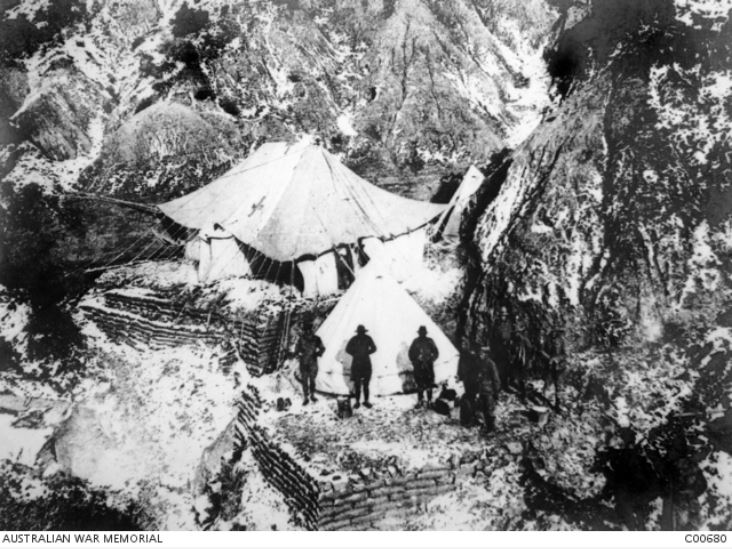4th Field Ambulance
From Our Contribution
 Staff at the 4th Field Ambulance Hospital on the Gallipoli Peninsula. AWM photo 00680 | |
Contents
Brief History
The 4th Field Ambulance was formed in Victoria, initially as part of the ANZAC Division. The unit was transported to Egypt as part of the 1st Convoy, with a change of ship in Colombo. On arrival in Alexandria they were transferred by rail to Heilwan and from there to Heliopolis where they undertook further training until early April 1915. The 4th Filed Ambulance travelled from Alexandria to Gallipoli aboard HMT Californian. Following a three day voyage the Ambulance reached Lemnos, remaining there until the armada sailed for Gallipoli. While some of the bearers landed late on the first day, it wasn't until 28 Apr 1915 that the rest of the Field Ambulance landed. After Gallipoli the Field Ambulance was assigned to the 4th Division along with the rest of the 4th Brigade, comprised of the 13th 14th 15th and 16th Battalions.
When an attack or advance was undertaken, the RAP would follow up the units' forward elements and were thus exposed to enemy direct fire (rifles and machine guns) and indirect fire (artillery mortar fire and even gas). The Field Ambulance would have personnel deployed forward to retrieve casualties from the Regimental Aid Post (RAP) to the Field Ambulance - generally described as a Casualty Clearing Station (CCS). They would have to deploy forward to reach the RAP, and thus come under the same risks as the front line combat troops. They may have had a number of means to assist in casualty evacuation from light rail, horse drawn vehicles and even motor vehicles. Or they could indeed also be stretcher borne. Field ambulance staff moved the wounded from the regimental aid post (just behind the front lines) to an advanced dressing station. The trip was about 1 to 3 miles (1.6 to 4.8km) and took around 6 hours to complete. Stretcher-bearers worked in relays. At least 36 stretcher-bearers handled each patient along the way.
Transport attached to a field ambulance included: three horse-drawn ambulance wagons; seven motorised ambulances; 10 general service wagons; three water carts; one motorcycle; one bicycle and one small two-wheeled Maltese cart.
Travelled from Alexandria to Gallipoli aboard HMT Californian, landing on 28 Apr 1915. This unit also served in France and Belgium. Fifty six personnel died while posted to this unit.
Unit Personnel
- Thomas Carberry MM MID 7 Nov 1914 - 28 Feb 1916
- Walter David Francis Kerridge 9 Dec 1917 - 31 Mar 1919
- John Murray
Patients
1915 Gallipoli
- † Victor Henry Marshall 22 May 1915 & 30 Aug 1915
- George Henry Martin MM MID 12 Aug 1915
- George Weston Firns 5 Sep 1915
- James Owen Horrocks 22 - 25 Oct 1915
1916
- † Ernest Edward Lockhart 27 Feb 1916
- Ernest Wells 29 Jul 1916
- Lionel William Gibbs 5 Aug 1916
- Alexander Russell Main14 Aug 1916
- Arthur Edward Bingham 13 Oct 1916
1917
- † Daniel Adkins Lewis 2 Apr 1917
- Clarence Victor Watson 2 Apr 1917
- John Henry Wilkinson 2 Apr 1917
- William Bertie Claude Moulden 4 - 9 Apr 1917
- Victor Norman Chandler MM 6 Apr 1917
- William Henry Gibbs 11 Apr 1917 & 10 Jul 1918 & 20 Sep 1918
- William Simpson 11-12 Apr 1917
- Sylvanus Benjamin Buckland 6 May 1917
- George Turner 1 - 3 Jul 1917
- Herbert James Reed 17 - 28 Jul 1917
- † Robert Prior Bailey 5 Aug 1917
- Benjamin Arthur McEvoy 5 Aug 1917
- Leonard George Morgan 26 Aug 1917
- George Emanuel Nettleton 28 Aug - ?? Sep 1917
- Leslie James Godfrey 30 Aug - 3 Sep 1917
- William Henry Baldwin ?? Oct 1917
1918
- George Weston Firns 14 Apr 1918
- Arthur James Allen 12 Jun 1918
- Albert John Llewellyn Reed 3 Aug 1918
- † Beverley Loxton Bennett 4 - 5 Jul 1918
- William Wright Casterton MM 4 Jul 1918
- Alfred Gittins 4 Jul 1918
- George Emanuel Nettleton 4 Jul 1918
- Ralph Trotter 4 Jul 1918
- William Wilfred Gerald Liddington 21 Aug 1918
- Samuel Arthur Vincent 15 Sep 1918
- Thomas William Moore 18 Sep 1918
- Ernest William George Reed 18 Sep 1918
- John Thomas Clements 1 Oct 1918
- Joseph Sowden Kidd MM 30 Nov 1918
Individual Honours
- 2 x Distinguished Service Order
- 6 x Military Cross
- 2 x Distinguished Conduct Medal
- 1 x Bar to Military Medal
- 49 x Military Medal
- 4 x meritorious Service Medal
- 9 x Mentioned in Despatches
- 1 x Belgium Croix de Guerre
- 1 x French Medaille Des Epidemies
Notes